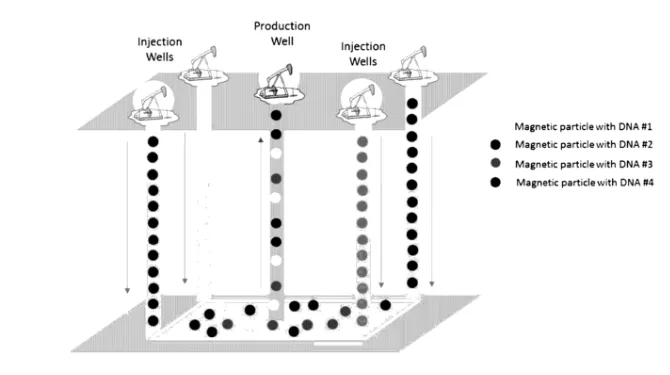Engineered Multifunctional Particles for Enhanced Oil Recovery
This technology can be used as an oil tracer, pH sensor, size detector, thermal detector, or ionization sensor in enhanced oil recovery. These particles can be used as several different sensors to increase oil recovery efficiency through a better understanding of the underground wells.
Researchers
-
multifunctional particles for enhanced oil recovery
United States of America | Granted | 10,442,982
Figures
Technology
The general principle of these nanoparticles is a silica or calcium carbonate (CaCO3) “shell” that encapsulates a desired surfactant. This surfactant can create micelles with different types of DNA to create various sensors. The thickness and size control the conditions of release. For an oil tracer, DNA is encapsulated in CaCO3, which can probe the structure of underground oil well systems and trace the external additives and their performance by having different DNA species corresponding to and injected with different additives. Additionally, DNA secondary structures, A-motif, form depending on the pH level. Coupling this with the plasmonics of gold nanoparticles, which allows particles creating A-motif to aggregate, a pH sensor is created and, due to aggregatation, will change color between pH 3-7.2. By changing the size of the particles, a pore size detector is created. Various sizes of particles with corresponding DNA species are pumped into the well and an understanding of the pore size underground is gained based on the DNA recovered. To create a thermal detector, changes in DNA structure past a threshold temperature are monitored. Therefore, several DNAs can determine if the temperature is within a certain range. Finally, the appearance and disappearance of the top band or dimer structure is highly correlated with the magnesium salt concentration. The detection of the top band enables verification if the salt concentration is above or below the neutral balance salt concentration, creating an ionization sensor.
Problem Addressed
Since surfactants can reduce interfacial tension between oil and water, delivery of surfactants to oil wells without any loss is crucial to the improvement of oil production and enhanced oil recovery (EOR). Therefore, a controlled delivery method is of interest. This method uses inorganic encapsulated surfactant nanoparticles and DNA to deliver surfactants and create several different sensors.
Advantages
- Nanoparticle size, thermal, pH, and ionization sensors
- Increased understanding of underground oil well conditions
License this technology
Interested in this technology? Connect with our experienced licensing team to initiate the process.
Sign up for technology updates
Sign up now to receive the latest updates on cutting-edge technologies and innovations.
